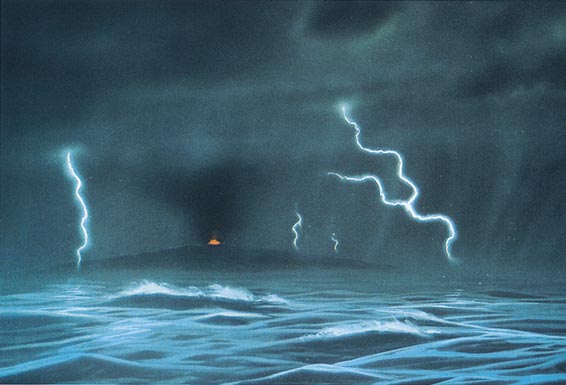
This Article From Issue
March-April 2001
Volume 89, Number 2
DOI: 10.1511/2001.18.0
The Spark of Life: Darwin and the Primeval Soup. Christopher Wills and Jeffrey Bada. xx + 291 pages. Perseus Publishing, 2000. $27.
In The Spark of Life: Darwin and the Primeval Soup, Christopher Wills and Jeffrey Bada attempt to extend Darwinian evolution to prebiotic chemistry on the early Earth.
Central to the classic "primeval soup" model for the origin of life on Earth is the work of Stanley Miller, begun in the early 1950s at the University of Chicago and continued at the University of California, San Diego, where he is a colleague of both authors and was Bada's thesis advisor. Miller passed electric sparks through a mixture of gases believed to approximate the chemical composition of the early Earth's atmosphere. Also included in the closed apparatus was a water reservoir simulating the ocean. The experiments produced significant amounts of several amino acids, as well as larger quantities of a complex mixture of organic macromolecules. From these experiments came a model for the origin of life in which small organic molecules were made in the Earth's atmosphere and then deposited by rainfall into the ocean, where they reacted further to make proteins, nucleic acids and the other molecules of life.

From The Spark of Life
Wills and Bada explain the basis for the assumptions (some of which have subsequently been questioned) that went into Miller's initial choice of experimental conditions. They also defend the primeval-soup idea against challenges from recently proposed alternatives. These include the possibility of synthesis of protobiologically useful molecules by the chemical and thermal gradients at deep-sea hydrothermal vents, as well as the possibility of important organic molecules having been delivered to the young planet from deep space by impacting comets and meteorites.
The authors then extend the primeval-soup hypothesis by postulating that the small organic molecules made in the atmosphere interacted selectively with larger organic molecules in oily films on beaches and in tide pools. In their model, some molecules were retained by the films and others were washed away into the vast ocean. This physicochemical selection resulted in a mixture of specific combinations of molecules that formed increasingly complex systems and eventually developed primitive biochemical functions.
The authors tie the death of the 19th-century theory of spontaneous generation of organisms from nonliving material to the emergence of theories that life on Earth originated through spontaneous generation, albeit under conditions not occurring on the Earth today. They also briefly mention the theory of panspermia—the idea that the early lifeless Earth was seeded with life from outer space (an idea recently revived to some extent by the recognition of meteorites that had traveled from Mars to Earth).
Wills and Bada explore the possible forms and functions of the first living organisms. They describe alternative genetic materials (which are neither DNA nor RNA), as well as some of the organizing principles that might have shaped the ability of the first cells to harvest energy and to develop internal structure. The book concludes with a discussion of potential environments for extraterrestrial life, both in our own solar system and in the increasing number of known extrasolar planetary systems.
The study of the origin and evolution of life is undergoing something of a renaissance. NASA recently launched a program called Astrobiology to raise the profile and funding level of this "new" scientific area of study, which Wills and Bada remind us extends back at least two centuries. The Spark of Life is a well-written introduction to the highly interdisciplinary and sometimes contentious field of origin-of-life and exobiology studies.—Gene D. McDonald, Jet Propulsion Laboratory, California Institute of Technology
American Scientist Comments and Discussion
To discuss our articles or comment on them, please share them and tag American Scientist on social media platforms. Here are links to our profiles on Twitter, Facebook, and LinkedIn.
If we re-share your post, we will moderate comments/discussion following our comments policy.